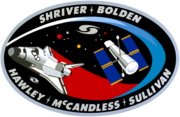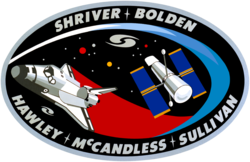STS-31
| STS-31 | |||||
 | |||||
| Uppdrag | 35 | ||||
|---|---|---|---|---|---|
| Rymdfärja | Discovery (10)[1] | ||||
| NSSDC-ID | 1990-037A[2] | ||||
| Färdens tid | 5 dagar, 1 timmar, 16 minuter, 6 sekunder | ||||
| Uppskjutning | |||||
| Startplats | Startplatta 39B vid Kennedy Space Center i Florida | ||||
| Start | 24 april 1990, 8:33:51 AM EDT | ||||
| Landning | |||||
| Landningsplats | Edwards Air Force Base | ||||
| Landning | 29 april 1990, 6:49:57 AM PDT | ||||
| Omloppsbana | |||||
| Varv | 80 st.[3] | ||||
| Apogeum | 615 km | ||||
| Perigeum | 585 km | ||||
| Banlutning | 28,45° | ||||
| Sträcka | 3 328 466 km | ||||
| Besättning | |||||
| Befälhavare | Loren J. Shriver (2) | ||||
| Pilot | Charles F. Bolden (2) | ||||
| Uppdragsspecialister | Steven A. Hawley (3) Bruce McCandless (2) Kathryn D. Sullivan (2) | ||||
 | |||||
| Kronologi Rymdfärjeprogrammet | |||||
| |||||
STS-31 är det 35:e uppdraget i NASA:s rymdfärjeprogram. Discovery lyfte från Pad-39B vid Kennedy Space Center 24 april 1990 för sin tionde rymdfärd. I lastutrymmet fanns bland annat rymdteleskopet Hubble och en IMAX-kamera.
Efter drygt fem dagar i omloppsbana runt jorden återinträdde rymdfärjan i jordens atmosfär och landade vid Edwards Air Force Base i Kalifornien.
Besättning
- Loren J. Shriver (2), befälhavare.
- Charles F. Bolden (2), pilot
- Steven A. Hawley (3), uppdragsspecialist 1
- Bruce McCandless (2), uppdragsspecialist 2
- Kathryn D. Sullivan (2), uppdragsspecialist 3
Väckningar
Under Geminiprogrammet började NASA spela musik för besättningar och sedan Apollo 15 har man varje "morgon" väckt besättningen med ett särskilt musikstycke, särskilt utvalt antingen för en enskild astronaut eller för de förhållanden som råder.
| Dag | Låt | Artist/Kompositör |
|---|---|---|
| 2 | "Space is Our World" | Private Numbers |
| 3 | "Shout" | Otis Day and the Knights |
| 4 | "Kokomo" | Beach Boys |
| 5 | "Cosmos" | Frank Hayes |
| 6 | "Rise and Shine" | Raffi |
Se även
Referenser
- ^ NASA Space Shuttle Launch Archive Arkiverad 15 augusti 2011 hämtat från the Wayback Machine., läst 28 juli 2016.
- ^ ”NASA Space Science Data Coordinated Archive” (på engelska). NASA. https://nssdc.gsfc.nasa.gov/nmc/spacecraft/display.action?id=1990-037A. Läst 18 mars 2020.
- ^ Manned Astronautics - Figures & Facts Arkiverad 25 mars 2016 hämtat från the Wayback Machine., läst 28 juli 2016.
Externa länkar
 Wikimedia Commons har media som rör STS-31.
Wikimedia Commons har media som rör STS-31.
| ||||||||||||||||||||||||||||||
| ||||||||
| ||||||||||||||||||||||||||||||||
Media som används på denna webbplats
Författare/Upphovsman: Pascal (Flickr user: pasukaru76), Licens: CC0
Vostok spacecraft replica at the Technik Museum Speyer, Germany.
STS-41 Mission Insignia
STS-36 Mission Insignia
STS-31 shuttle mission flight insignia. The mission insignia for NASA's STS-31 mission features the Hubble Space Telescope (HST) in its observing configuration against a background of the universe it will study. The cosmos includes a stylistic depiction of galaxies in recognition of the contribution made by Sir Edwin Hubble to our understanding of the nature of galaxies and the expansion of the universe. The STS-31 crew points out that is it in honor of Hubble's work that this great observatory in space bears his name. The depicted Space Shuttle trails a spectrum symbolic of both the red shift observations that were so important to Hubble's work and new information which will be obtained with the HST. Encircling the art work, designed by the crew, are the names of its members.
The STS-31 crew of five included (left to right) Charles F. Bolden, pilot; Steven A. Hawley, mission specialist; Loren J. Shriver, commander; Bruce McCandless, mission specialist; and Kathryn D. Sullivan, mission specialist. Launched aboard the Space Shuttle Discovery on April 24, 1990 at 8:33:51am (EDT), the primary payload was the Hubble Space Telescope. This was the first flight to use carbon brakes at landing.
- The five astronaut crew members for the STS-31 mission chose a busy night sky scene as a background for their portrait. Loren J. Shriver (center front) is mission commander. Other crew members are (left to right), Charles F. Bolden Jr., pilot; Steven A. Hawley, Bruce McCandless II, and Kathryn D. Sullivan, all mission specialists. The Hubble Space Telescope, depicted in the upper left of the background scene, was deployed by Discovery’s crew on April 25, 1990.
The Hubble Space Telescope as seen from the departing Space Shuttle Atlantis, flying STS-125, HST Servicing Mission 4.










